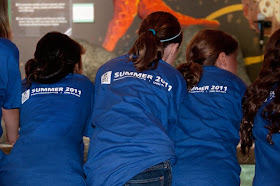
This weekend, Cari Garand and Wendy Hanson did an end of summer tide pool collecting trip, along with volunteer John Aurelius who generously lets Pacific Science Center collect from his beach at Indianola.

Trained beach naturalists, Cari and Wendy collected carefully, taking only organisms allowed on our permit, and leaving animals as they found them if they could not be used in our tide pool exhibit.

Here are the animals that Cari and Wendy brought back:
Hermit crabs: 15
Mottled Star: smaller ones, 4
Shrimp: 2 very little
Limpets: no large ones, but many small ones came in attached to other animals
Painted Anemone: 1
Aggregating Anemone: 4 mostly came attached to stuff
Moon Snail Egg Cases: 3
Barnacle covered rocks: 10
Chitons: 3, 2 bigger mossy or possibly hairy ones and one small lined
Snails: 8

In addition to the animals we might expect from a collection, our team spotted a bunch of the coolest looking items we’ve seen! The gelatinous, finger like objects are squid egg cases, and you can actually see the baby squids floating around inside the case.

Of course, Cari and Wendy wished they could bring some of these cases back, but knew that our system would not support such large, free swimming predators as mature squids. So the cases stayed on the beach.

Cari and Wendy used their professional experience to assess which animals would work best in our Puget Sound Salt Water Tide Pool. But being professional does not mean the collectors didn’t feel the wonder and excitement of being on a beach.

We encourage everyone to visit one of our local beaches, and spend time getting to know Puget Sound better. Bring your camera; you never know what amazing pictures may be out there.


























